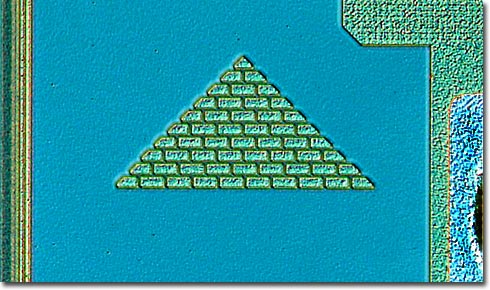The Intel Pyramid

|
A miniature pyramid was built by the Intel chip designers on a single corner of all 486DX2 microprocessor dies that we have examined. The significance of the pyramid escapes us, but we would be interested to learn the meaning of this silicon artwork. Intel's revolutionary and innovative clock doubling microprocessor technology debuted in 1992 with the introduction of the 25 MHz clock-doubled 486DX2 processor that had an internal clock rate of 50 MHz. This was of tremendous benefit to motherboard makers who could easily fabricate boards with 25 MHz clock speeds utilizing the clock-doubled processor, translating into a faster computers at lower production costs. The down side is that external operations still occurred at the lower clock speed and memory accesses and transfers to and from the input/output devices were much slower than internal chip operations. The 486DX2 was the first Intel processor to utilize 0.8-micron technology to produce a chip with 1.2 million transistors. While still able to address 4 Gigabytes of memory, the chip could process instructions at 54 million per second. |
© 1995-2025 by Michael W. Davidson and The Florida State University. All Rights Reserved. No images, graphics, software, scripts, or applets may be reproduced or used in any manner without permission from the copyright holders. Use of this website means you agree to all of the Legal Terms and Conditions set forth by the owners.
This website is maintained by our
|